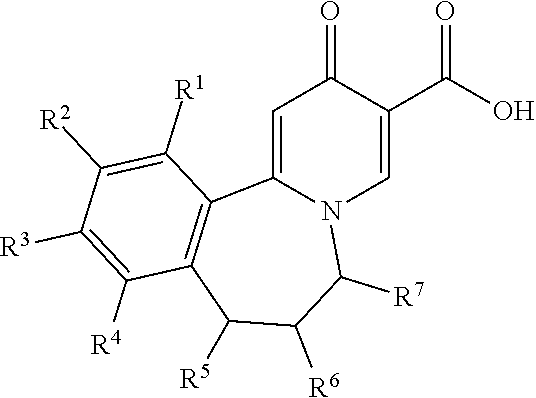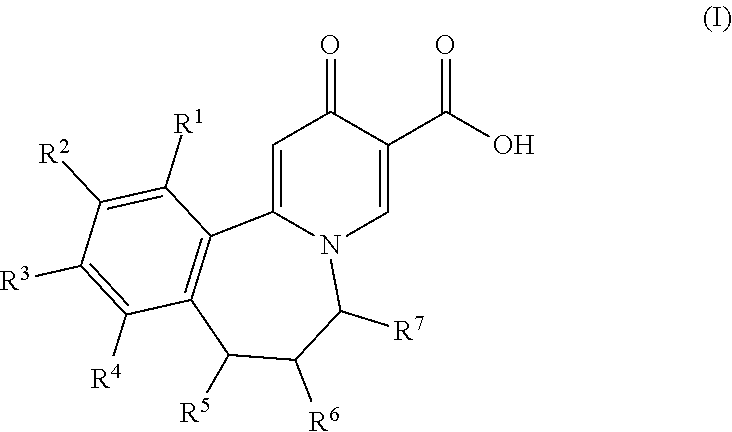Tricyclic 4-pyridone-3-carboxylic acid derivatives for the treatment and prophylaxis of hepatitis B virus infection
a technology of hepatitis b virus and derivatives, applied in the field of new drugs, can solve the problems of chronically infected patients only showing weak immune responses, and the hbv infection remains a major health problem, and achieve the effect of superior anti-hbv activity and treatment or prophylaxis
- Summary
- Abstract
- Description
- Claims
- Application Information
AI Technical Summary
Benefits of technology
Problems solved by technology
Method used
Image
Examples
example a
[0102]A compound of formula I can be used in a manner known per se as the active ingredient for the production of tablets of the following composition:
[0103]
Per tabletActive ingredient200 mgMicrocrystalline cellulose155 mgCorn starch 25 mgTalc 25 mgHydroxypropylmethylcellulose 20 mg425 mg
example b
[0104]A compound of formula I can be used in a manner known per se as the active ingredient for the production of capsules of the following composition:
[0105]
Per capsuleActive ingredient100.0 mgCorn starch 20.0 mgLactose 95.0 mgTalc 4.5 mgMagnesium stearate 0.5 mg220.0 mg
Indications and Methods of Treatment
[0106]The compounds of the invention can inhibit HBsAg production or secretion and inhibit HBV gene expression. Accordingly, the compounds of the invention are useful for the treatment or prophylaxis of HBV infection.
[0107]The invention relates to the use of a compound of formula I for the inhibition of HBsAg production or secretion.
[0108]The invention relates to the use of a compound of formula I for the inhibition of HBV DNA production.
[0109]The invention relates to the use of a compound of formula I for the inhibition of HBV gene expression.
[0110]The invention relates to the use of a compound of formula I for the treatment or prophylaxis of a HBV infection. The invention furthe...
example 1
ethoxy-2-oxo-7,8-dihydro-6H-pyrido[2,1-a][2]benzazepine-3-carboxylic acid
[0157]
Step 1: Preparation of N-[3-(3,4-dimethoxyphenyl)propyl]formamide
[0158]
[0159]A mixture of 3-(3, 4-dimethoxyphenyl)propan-1-amine (1.95 g, 10 mmol) and ethyl formate (20 mL) was refluxed for 16 hrs. Then the mixture was concentrated under reduced pressure and the residue was purified by column chromatography to give N-[3-(3,4-dimethoxyphenyl)propyl]formamide (1.5 g).
Step 2: Preparation of 7,8-dimethoxy-4,5-dihydro-3H-2-benzazepine
[0160]
[0161]To a solution of N-[3-(3,4-dimethoxyphenyl)propyl]formamide (224 mg, 1 mmol) in CH2Cl2 under nitrogen was added oxalyl chloride (140 mg, 1.1 mmol). The solution was stirred at rt for 30 mins, then cooled to −10° C. To the cooled reaction mixture was added iron(II) chloride (180 mg, 1.1 mmol). The resulting mixture was allowed to warm to rt and stirred for 24 hrs. Then the reaction was quenched by addition of 2 M hydrochloric acid (10 mL), and the resulting biphasic mix...
PUM
| Property | Measurement | Unit |
|---|---|---|
| temperature | aaaaa | aaaaa |
| pH | aaaaa | aaaaa |
| particle size | aaaaa | aaaaa |
Abstract
Description
Claims
Application Information
 Login to View More
Login to View More - R&D
- Intellectual Property
- Life Sciences
- Materials
- Tech Scout
- Unparalleled Data Quality
- Higher Quality Content
- 60% Fewer Hallucinations
Browse by: Latest US Patents, China's latest patents, Technical Efficacy Thesaurus, Application Domain, Technology Topic, Popular Technical Reports.
© 2025 PatSnap. All rights reserved.Legal|Privacy policy|Modern Slavery Act Transparency Statement|Sitemap|About US| Contact US: help@patsnap.com



